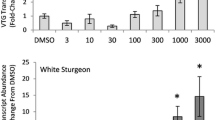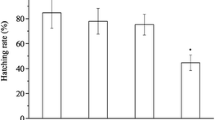Abstract
Many persistent organic pollutants are known to have endocrine-disrupting effects in several aquatic and terrestrial species. In this regard, hydroxylated metabolites of polychlorinated biphenyls (OH-PCBs) represent serious health and environmental concern because they are shown to act agonistic or antagonistic at hormone receptors (HRs) or to cause hormone-receptor-mediated responses. In the present study, salmon primary hepatocytes were used to study alterations in an estrogen signaling pathway resulting from exposure to four hydroxylated (4OH-CB 107, 4OH-CB146, 4OH-CB187, and 3OH-CB138) metabolites of PCB at different concentrations using quantitative real-time polymerase chain reaction. The effects of the PCB metabolites were compared to the mRNA expression in 17α-ethynylestradiol (EE2)-treated cells. Concentration-specific increase of vitellogenin (Vtg) mRNA transcription after exposure to OH-PCBs was observed. Decreased mRNA transcription was observed for zona radiata protein (Zr-protein) and cytochrome P450 side-chain cleavage (P450scc) enzyme. For estrogen receptor β (ERβ), the mRNA expression pattern was OH-PCB-metabolite congener-specific. A novel aspect of this study is that OH-PCBs produced effects on hepatic steroidogenic pathways by targeting the StAR protein and P450scc genes. Given that endocrine toxicology research mainly has focused on estrogenicity involving direct ER-mediated effects and that steroidogenic enzyme and proteins are highly tissue- and cell-type-specific and controlled by different promoters and second-messenger pathways, the present findings provide potential new targets for interaction with xenobiotics such as hydroxylated congeners of certain chemicals. The quantitative expression patterns of hepatic and extrahepatic steroidogenic genes and proteins after exposure to environmental contaminants are the subject of systematic investigations in our laboratory.







Similar content being viewed by others
References
Aluru N, Renaud R, Leatherland JF, Vijayan MM (2005) Ah receptor-mediated impairment of interrenal steroidogenesis involves StAR protein and P450scc gene attenuation in rainbow trout. Toxicol Sci 84:260–269
Andersson T, Förlin L, Hansson T (1983) Biotransformation of 7-ethoxycoumarin in isolated perfused rainbow trout liver. Drug Metab Dispos 11:494–498
Andersson PL, Blom A, Johannisson A et al (1999) Assessment of PCBs and hydroxylated PCBs as potential xenoestrogens: in vitro studies based on MCF-7 cell proliferation and induction of vitellogenin in primary culture of rainbow trout hepatocytes. Arch Environ Contam Toxicol 37:145–150
Arukwe A (2005) Modulation of brain steroidogenesis by affecting transcriptional changes of steroidogenic acute regulatory (StAR) protein and cholesterol side chain cleavage (P450 SCC ) in juvenile Atlantic salmon (Salmo salar) is a novel aspect of nonylphenol toxicity. Environ Sci Technol 39:9791–9798
Barannikova IA, Dyubin VP, Bayunova LV, Semenkova TB (2002) Steroids in the control of reproductive function in fish. Neurosci Behav Physiol 32:141–148
Bergman Å, Klasson-Wehler E, Kuroki H (1994) Selective retention of hydroxylated PCB metabolites in blood. Environ Health Perspect 102:464–469
Berry MN, Friend DS (1969) High-yield preparations of isolated rat liver parenchymal cells. A biochemical and fine structural study. J Cell Biol 43:506–520
Brouwer A, Blaner WS, Kukler A, Van den Berg K (1998) Study on the mechanism of interference of 3, 4, 3′,4′-tetrachlorobiphenyl with the plasma retinol-binding proteins in rodents. Chem Biol Interact 68:203–217
Buckman AH, Brown SB, Hoekstra PF, Solomon KR, Fisk AT (2004) Toxicokinetics of three polychlorinated biphenyl technical mixtures in rainbow trout (Oncorhynchus mykiss). Environ Toxicol Chem 23:1725–1736
Campbell LM, Muir DCG, Whittle DM, Backus S, Norstrom RK, Fisk AT (2003) Hydroxylated PCBs and other chlorinated phenolic compounds in lake trout (Salvelinus namaycush) blood plasma from the Great Lakes region. Environ Sci Technol 37:1720–1725
Carlson DB, Williams DE (2001) 4-hydroxy 2′,4′,6′ trichlorobiphenyl and 4-hydroxy-2′,3′,4′,5′-tetrachlorobiphenyl are estrogenic in rainbow trout. Environ Toxicol Chem 20:351–358
Connor K, Ramamoorthy K, Moore M et al (1997) Hydroxylated polychlorinated biphenyls (PCBs) as estrogens and antiestrogens: structure-activity relationships. Toxicol Appl Pharmacol 145:111–123
Crews D, Bergeron JM, McLachlan JA (1995) The role of estrogens in turtle sex determination and the effects of PCBs. Environ Health Perspect 103(Suppl 7):73–77
Dickson KL, Giesy R, Parrish R, Wolfe L (1994) Closing remarks: summary and conclusions. In: Hamelink JL, Landrum PF, Bergman HL, Benson WH (eds) Bioavailability: physical, chemical and biological interaction. Lewis Publishers, Boca Raton, FL, pp 221–230
Fängström B, Athanasiadou M, Grandjean P, Weihe P, Bergman Å (2002) Hydroxylated PCB metabolites and PCBs in serum from pregnant Faroese women. Environ Health Perspect 101:895–899
Finne EF, Cooper GA, Koop BF, Hylland K, Tollefsen KE (2007) Toxicogenomic responses in rainbow trout (Oncorhynchus mykiss) hepatocytes exposed to model chemicals and a synthetic mixture. Aquat Toxicol 81:293–303
Flouriot G, Pakdel F, Valotaire Y (1996) Trancriptional and post-transcriptional regulation of rainbow trout estrogen receptor and vitellogenin gene expression. Mol Cell Endocrinol 124:173–183
Goerke H, Weber K (2001) Species-specific elimination of polychlorinated biphenyls in estuarine animals and its impact on residue patterns. Marine Environ Res 51:131–149
Greytak SR, Callard GV (2007) Cloning of three estrogen receptors (ER) from killifish (Fundulus heteroclitus): differences in populations from polluted and reference environments. Endocrinology 150:174–188
Gu YZ, Hogenesch JB, Bradfield CA (2000) The PAS superfamily: sensors of environmental and developmental signals. Annu Rev Pharmacol Toxicol 40:519–561
Hawkins MB, Thomas P (2004) The unusual binding properties of the third distinct teleost estrogen receptor subtype ERβ are accompanied by highly conserved amino acid changes in the ligand binding domain. Endocrinology 145:2968–2977
Hewitt SC, Korach KS (2002) Estrogen receptors: structure, mechanisms and function. Rev Endocr Met Dis 3:193–200
James MO (2001) Polychlorinated biphenyls: metabolism and metabolites. In: Robertson RW, Hansen LG (eds) PCBs. Recent advances in environmental toxicology and health effects. The University Press of Kentucky, Lexington, pp 35–46
Kimura-Kuroda J, Nagata I, Kuroda Y (2007) Disrupting effects of hydroxy-polychlorinated biphenyl (PCB) congeners on neuronal development of cerebellar Purkinje cells: a possible causal factor for developmental brain disorders? Chemosphere 67:412–420
King SR, Manna PR, Ishii I et al (2002) An essential component in steroid synthesis, the steroidogenic acute regulatory protein, is expressed in discrete regions of the brain. J Neurosci 22:10613–10620
Koga N, Beppu M, Yoshimura H (1990) Metabolism in vivo of 3,4,5,3′,4′-pentachlorobiphenyl and toxicological assessment of the metabolite in rats. J Pharmacobiodyn 13:497–506
Kramer VJ, Giesy JP (1999) Specific binding of hydroxylated polychlorinated biphenyl metabolites and other substances to bovine calf uterine estrogen receptor: structure-binding realationships. Sci Total Environ 233:141–161
Lans MC, Klasson-Wehler E, Willemsen M, Meussen M, Safe S, Brouwer A (1993) Structure-dependent, competitive interaction of hydroxy-polychlorobiphenyls, -dibenzo-p-dioxins and -dibenzofurans with human transthyretin. Chem Biol Interact 88:7–21
Letcher RJ, Klasson-Wehler E, Bergman Å (2000) Methyl sulfone and hydroxylated metabolites of polychlorinated biphenyls. In: Paasivirta J (ed) The handbook of environmental chemistry: New types of persistent halogenated compounds: 3. Springer-Verlag, Berlin, pp 315–359
Letcher RJ, Lemmen JG, van den Burg B et al (2002) In vitro antiestrogenic effects of aryl methyl sulfone metabolites of polychlorinated biphenyls and 2,2-bis(4-chlorophenyl)-1,1-dichloroethene on 17beta-estradiol-induced gene expression in several bioassay systems. Toxicol Sci 69:362–372
Lyssimachou A, Jenssen BM, Arukwe A (2006) Brain cytochrome P450 aromatase gene isoforms and activity levels in Atlantic salmon after waterborne exposure to nominal environmental concentrations of the pharmaceutical ethynylestradiol and antifoulant tributyltin. Toxicol Sci 91:82–92
Lyssimachou A, Arukwe A (2007) Regulation of brain and interrenal StAR protein, P450scc and CYP11β mRNA levels in Atlantic salmon (Salmo salar) after nominal waterborne exposure to the synthetic pharmaceutical estrogen, Ethynylestradiol. J Toxicol Environ Health 70:1–8
Malmberg T, Hoogstraate J, Bergman A, Klasson Wehler E (2004) Pharmacokinetics of two major hydroxylated polychlorinated biphenyl metabolites with specific retention in rat blood. Xenobiotica 34:581–589
Matthews J, Gustafsson JÅ (2003) Estrogen signalling: a subtle balance between ERα and ERβ. Mol Intervent 3:281–292
Matthews J, Gustafsson JÅ (2006) Estrogen receptor and aryl hydrocarbon receptor signalling pathways. Nucl Recept Signal 4:1–4
Meucci V, Arukwe A (2006) Transcriptional modulation of brain and hepatic estrogen receptor and P450arom isotypes in juvenile Atlantic salmon (Salmo salar) after waterborne exposure to the xenoestrogen, 4-nonylphenol. Aquat Toxicol 77:167–177
Moore M, Mustain M, Daniel K et al (1997) Antiestrogenic activity of hydroxylated polychlorinated biphenyl congeners identified in human serum. Toxicol Appl Pharmacol 142:160–168
Mortensen AS, Arukwe A (2007) Modulation of xenobiotic biotransformation system and hormonal responses in Atlantic salmon (Salmo salar) after exposure to tributyltin (TBT). Comp Biochem Physiol C 145:431–441
Mortensen AS, Braathen M, Sandvik M, Arukwe A (2007) Effects of hydroxy-polychlorinated biphenyl (OH-PCB) congeners on the xenobiotic biotransformation gene expression patterns in primary culture of Atlantic salmon (Salmo salar) hepatocytes. Ecotoxicol Environ Safet 68:351–360
Safe S, Wormke M, Samudio I (2000) Mechanisms of inhibitory aryl hydrocarbon receptor-estrogen receptor crosstalk in human breast cancer cells. J Mammary Gland Biol Neoplasia 5:295–306
Sandau CD, Ayotte P, Dewailly E, Duffe J, Norstrom RJ (2000) Analysis of hydroxylated metabolites of PCBs (OH-PCBs) and other chlorinated phenolic compounds in whole blood from Canadian inuit. Environ Health Perspect 108:611–616
Snyder SA, Keith TL, Verbrugge DA et al (1999) Analytical methods for detection of selected estrogenic compounds in aqueous mixtures. Environ Sci Technol 33:2814–2810
Specker JL, Sullivan CV (1994) Vitellogenesis in fishes: status and perspectives. In: Davey KG, Peter RE, Tobe SS (eds) Perspectives in comparative endocrinology. National Research Council of Canada, Ottawa, pp 304–315
Stocco DM (2001) StAR protein and the regulation of steroid hormone biosynthesis. Annu Rev Physiol 63:193–213
Stocco DM, Clark BJ, Reinhart AJ et al (2001) Elements involved in the regulation of the StAR gene. Mol Cell Endocrinol 177:55–59
Thomann RV (1989) Bioaccumulation model of organic chemical distribution in aquatic food chains. Environ Sci Technol 23:699–707
van den Berg M, Birnbaum LS, Denison M et al (2006) The 2006 World Health Organisation reevaluation of human and mammalian toxic equivalency factors for dioxins and dioxin-like compounds. Toxicol Sci 93:223–241
Walsh LP, Kuratko CN, Stocco DM (2000) Econazole and miconazole inhibit steroidogenesis and disrupt steroidogenic acute regulatory (StAR) protein expression post-transcriptionally. J Steroid Biochem Mol Biol 75:229–236
Wang Y, Ge W (2004) Developmental profiles of activin betaA, betaB, and follistatin expression in the zebrafish ovary: evidence for their differential roles during sexual maturation and ovulatory cycle. Biol Reprod 71:2056–2064
Wilson CL, Safe S (1998) Mechanisms of ligand-induced aryl hydrocarbon receptor-mediated biochemical and toxic responses. Toxicol Pathol 26:657–671
Yadetie F, Arukwe A, Goksøyr A (1999) Induction of hepatic estrogen receptor in juvenile Atlantic salmon in vivo by the environmental estrogen, 4-nonylphenol. Sci Total Environ 233:201–210
Acknowledgments
This study was financed by the Magne Lerheims stipend, Norwegian Research Council (NFR) doctoral grant to MB and a Norwegian University of Science and Technology (NTNU) doctoral fellowship grant to ASM.
Author information
Authors and Affiliations
Corresponding author
Rights and permissions
About this article
Cite this article
Braathen, M., Mortensen, A.S., Sandvik, M. et al. Estrogenic Effects of Selected Hydroxy Polychlorinated Biphenyl Congeners in Primary Culture of Atlantic Salmon (Salmo salar) Hepatocytes. Arch Environ Contam Toxicol 56, 111–122 (2009). https://doi.org/10.1007/s00244-008-9163-0
Received:
Accepted:
Published:
Issue Date:
DOI: https://doi.org/10.1007/s00244-008-9163-0




